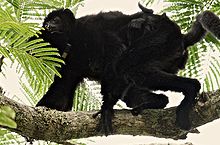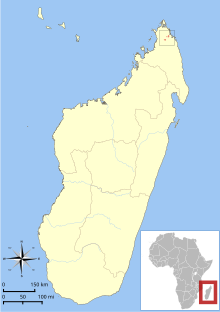
The Indriidae are a family of strepsirrhine primates. They are medium- to large-sized lemurs, with only four teeth in the toothcomb instead of the usual six. Indriids, like all lemurs, live exclusively on the island of Madagascar.

A sifaka is a lemur of the genus Propithecus from the family Indriidae within the order Primates. The name of their family is an onomatopoeia of their characteristic "shi-fak" alarm call. Like all lemurs, they are found only on the island of Madagascar. All species of sifakas are threatened, ranging from endangered to critically endangered.

The Madagascar dry deciduous forests represent a tropical dry forest ecoregion situated in the western and northern part of Madagascar. The area has high numbers of endemic plant and animal species but has suffered large-scale clearance for agriculture. They are among the world's richest and most distinctive dry forests and included in the Global 200 ecoregions by the World Wide Fund. The area is also home to distinctive limestone karst formations known as tsingy, including the World Heritage Site of Bemaraha.
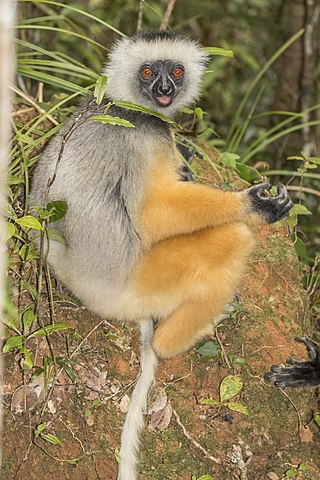
The diademed sifaka, or diademed simpona, is an endangered species of sifaka, one of the lemurs endemic to certain rainforests in eastern Madagascar. Along with the indri, this species is one of the two largest living lemurs, with an average weight of 6.5 kg and a total adult length of approximately 105 centimetres (41 inches), half of which is its tail. Russell Mittermeier, one of the contemporary authorities on lemurs, describes the diademed sifaka as "one of the most colorful and attractive of all the lemurs", having a long and silky coat. P. diadema is also known by the Malagasy names simpona, simpony and ankomba joby. The term "diademed sifaka" is also used as a group species designation formerly encompassing four distinct subspecies.

Coquerel's sifaka is a diurnal, medium-sized lemur of the sifaka genus Propithecus. It is native to northwest Madagascar. Coquerel's sifaka was once considered to be a subspecies of Verreaux's sifaka, but was eventually granted full species level, and is listed as Critically Endangered on the IUCN Red List due to habitat loss and hunting. In popular culture, it is known for being the species of the title character in the children's TV show Zoboomafoo. The species was named after French entomologist Charles Coquerel.

The golden-crowned sifaka or Tattersall's sifaka is a medium-sized lemur characterized by mostly white fur, prominent furry ears, and a golden-orange crown. It is one of the smallest sifakas, weighing around 3.5 kg (7.7 lb) and measuring approximately 90 cm (35 in) from head to tail. Like all sifakas, it is a vertical clinger and leaper, and its diet includes mostly seeds and leaves. The golden-crowned sifaka is named after its discoverer, Ian Tattersall, who first spotted the species in 1974. However, it was not formally described until 1988, after a research team led by Elwyn L. Simons observed and captured some specimens for captive breeding. The golden-crowned sifaka most closely resembles the western forest sifakas of the P. verreauxi group, yet its karyotype suggests a closer relationship with the P. diadema group of eastern forest sifakas. Despite the similarities with both groups, more recent studies of its karyotype support its classification as a distinct species.

The northern rufous mouse lemur, northern brown mouse lemur, or Tavaratra mouse lemur is found in northern Madagascar from the Ankarana Special Reserve in the west to the Manambato River in the northeast, and up to the Irodo River in the north of the Analamerana Special Reserve. The complete distribution range of M. tavaratra is still to be defined as some areas surrounding the described distribution have not been visited yet. For example, M. tavaratra has been reported to possibly occur from the Irodo up to the Montagne des Français. Its known distribution cover four protected areas – the Ankarana Special Reserve, and the Analamerana Special Reserve both managed by Madagascar National Parks, the Loky-Manambato protected area (Daraina), and the Andavakoeira-Andrafiamena protected area, both Managed by the NGO Fanamby
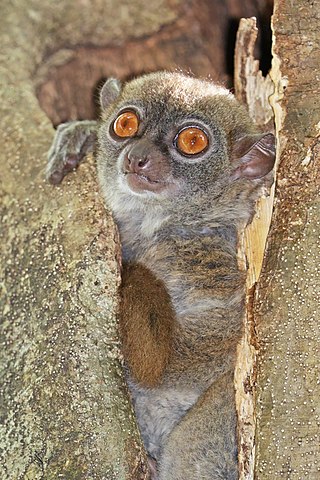
The Ankarana sportive lemur, or Ankarana weasel lemur, is a sportive lemur endemic to Madagascar. It is one of the smaller sportive lemurs with a total length of about 53 cm (21 in), including 25 cm (9.8 in) of tail. Average body weight is approximately 750 grams (1.65 lb). The Ankarana sportive lemur is found in northern Madagascar, living in dry lowland forests in Ankarana, Andrafiamena and Analamerana, and in moist montane forest of Montagne d'Ambre.

The western lesser bamboo lemur, also known as the northern bamboo lemur, western gentle lemur, or Sambirano lesser bamboo lemur, is a species of bamboo lemur endemic to Madagascar.

The silky sifaka is a large lemur characterized by long, silky, white fur. It has a very restricted range in northeastern Madagascar, where it is known locally as the simpona. It is one of the rarest mammals on Earth. The silky sifaka is one of nine sifaka species, and one of four former subspecies of diademed sifaka (P. diadema). Studies in 2004 and 2007 compared external proportions, genetics, and craniodental anatomy supporting full species status, which has generally been accepted.
Analamerana Special Reserve is a 347 square kilometres (134 sq mi) wildlife reserve in the north of Madagascar. The reserve was created in 1956 to protect its endemic plants and animals, such as the critically endangered Perrier's sifaka, which is considered to be one of the most endangered primates in the world.
Ambatovaky Special Reserve is a tropical rainforest and wildlife reserve in the north-east of Madagascar. It is designated by Bird Life International as an Important Bird Area for the large number of endemic species of birds.

The Daraina sportive lemur is a sportive lemur endemic to Madagascar. It is a relatively small sportive lemur with a total length of about 49 to 56 cm, of which 24–27 cm (9.4–10.6 in) are tail.

The crowned sifaka is a sifaka endemic to western Madagascar, a part of the world where nature and its biological diversity faces enormous and devastating consequences resulting from anthropogenic activities. It is a species of lemur belonging to the Idriidae family, it is of comparable size to the Golden-crowned sifaka and up to a meter in length, of which 47-57 centimeters are tail. The species is an arboreal vertical climber and leaper whose diet consists of leaves, fruits and flowers. It is threatened by habitat destruction caused by human activities and is currently classified as critically endangered by the IUCN. Conservation planning needs to take local people needs and views into account in order to be successful over the long term.
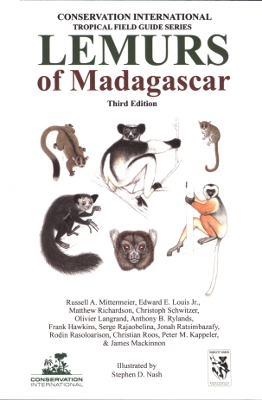
Lemurs of Madagascar is a 2010 reference work and field guide for the lemurs of Madagascar, giving descriptions and biogeographic data for the known species. The primary contributor is Russell Mittermeier, president of Conservation International, and the cover art and illustrations were drawn by Stephen D. Nash. Currently in its third edition, the book provides details about all known lemur species, general information about lemurs and their history, and also helps travelers identify species they may encounter. Four related pocket field guides have also been released, containing color illustrations of each species, miniature range maps, and species checklists.

The World's 25 Most Endangered Primates is a list of highly endangered primate species selected and published by the International Union for Conservation of Nature (IUCN) Species Survival Commission (SSC) Primate Specialist Group (PSG), the International Primatological Society (IPS), Global Wildlife Conservation (GWC), and Bristol Zoological Society (BZS). The IUCN/SSC PSG worked with Conservation International (CI) to start the list in 2000, but in 2002, during the 19th Congress of the International Primatological Society, primatologists reviewed and debated the list, resulting in the 2002–2004 revision and the endorsement of the IPS. The publication was a joint project between the three conservation organizations until the 2012–2014 list when BZS was added as a publisher. The 2018–2020 list was the first time Conservation International was not among the publishers, replaced instead by GWC. The list has been revised every two years following the biannual Congress of the IPS. Starting with the 2004–2006 report, the title changed to "Primates in Peril: The World's 25 Most Endangered Primates". That same year, the list began to provide information about each species, including their conservation status and the threats they face in the wild. The species text is written in collaboration with experts from the field, with 60 people contributing to the 2006–2008 report and 85 people contributing to the 2008–2010 report. The 2004–2006 and 2006–2008 reports were published in the IUCN/SSC PSG journal Primate Conservation,, since then they have been published as independent publications.

Milne-Edwards's sifaka, or Milne-Edwards's simpona, is a large arboreal, diurnal lemur endemic to the eastern coastal rainforest of Madagascar. Milne-Edwards's sifaka is characterized by a black body with a light-colored "saddle" on the lower part of its back. It is closely related to the diademed sifaka, and was until recently considered a subspecies of it. Like all sifakas, it is a primate in the family Indriidae.

Lemurs' Park is a small botanical garden and lemur reserve covering 5 ha, and is located 22 km (14 mi) southwest of Antananarivo, Madagascar. It was founded around 2000 by Laurent Amouric and Maxime Allorge. Most of its nine lemur species are free-ranging within the park, which also contains more than 70 of Madagascar's endemic plant species. The park is open to the public, offering guided tours as well as standard amenities, a gift shop, and a restaurant. Visitors can arrange transportation between downtown Antananarivo and Lemurs' Park on a private park shuttle.
The Ankarana dwarf lemur or Sheth's dwarf lemur is a species of dwarf lemur, part of the C. medius group, known only from northern Madagascar. It has been found in two reserves as well as two protected areas. It was identified in 2014, but not formally described until 2016. Its conservation status has not been determined, but it is at risk from habitat destruction due to daily resource extraction by local human populations.
